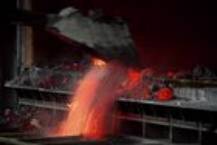INDUSTRIAL
CONCERNS
Industrial power demands drive the
need for Lower Snake River Dams. The
four lower snake dams (Lower Granite, Little Goose, Lower Monument, and Ice
Harbor) are run of river structures, a design which limits the number of
functions that they can realistically perform.
The lack of actual storage at each facility limits the dams from
providing any significant flood storage, limiting the actual benefits to
navigation and hydropower. Cheap
power, however, is the largest industrial benefit.
The dams each have an electrical capacity of 810 mega-Watts (MW), except
for Ice Harbor, which has a capacity of 603 MW. Altogether, the lower snake has a capacity of 3,033 MW –
enough to power 3,033,000 homes. The
dams rarely run at capacity, though, depending heavily on the quantity of flow
to run the turbines.
Industrial
impacts
 There
are ten regional aluminum smelters that depend upon the cheap electricity for
the refinement of bauxite. In all,
the region can smelt nearly 1,700 thousand tons of aluminum per year: the gross
annual income could feasibly approach $200 million.
In order to produce the total capacity the plants require approximately
3,145 MW of electricity. A recent
analysis of the aluminum industry (February 2001) estimated that the Bonneville
Power Administration (BPA) would provide approximately 1,400 MW of the necessary
energy to run all ten plants at capacity, with the rest being acquired
elsewhere. Since the lower Snake dams rarely run at capacity, their
average power production typically equals that of Aluminum’s allotment.
There
are ten regional aluminum smelters that depend upon the cheap electricity for
the refinement of bauxite. In all,
the region can smelt nearly 1,700 thousand tons of aluminum per year: the gross
annual income could feasibly approach $200 million.
In order to produce the total capacity the plants require approximately
3,145 MW of electricity. A recent
analysis of the aluminum industry (February 2001) estimated that the Bonneville
Power Administration (BPA) would provide approximately 1,400 MW of the necessary
energy to run all ten plants at capacity, with the rest being acquired
elsewhere. Since the lower Snake dams rarely run at capacity, their
average power production typically equals that of Aluminum’s allotment.
Thus, aluminum industry is the
largest industrial stakeholder for cheap hydropower in the region.
In all, there are 10,370 high-paying industrial jobs associated with the
industry, which support an estimated 39,550 jobs in the region.
(“Supported jobs” are jobs that depend upon the steady employment of
the aluminum industry: for instance, the transport companies who serve only the
bauxite demand of the aluminum industry are ‘support jobs.’)
The total regional employment by Big Aluminum, therefore, is 0.65%.
Were the aluminum industry to vanish overnight, that would be the
regional increase in unemployment.

The aluminum industry is highly
reliant upon BPA for rates low enough to remain internationally competitive.
Many of the smelters use antiquated equipment and relatively inefficient
processes, which could make it difficult for them to maintain their stance in
the global aluminum market. Several
other global producers, who use the latest technologies, are restrained by their
debt in building the facilities – keeping the older debt free plants
competitive. The low price for power is the largest factor in keeping the
smelters competitive.
Regional
Dependence on Industry
The aluminum industry employment
is not a significant factor in the region as a whole. Klickitat County, however, relies upon the Goldendale smelter
for nearly 8% of its employment. Wasco
County, Oregon receives nearly 4% of its employment from the Dalles smelter.
Other rural smelters only provide 1 or 2 percent of the regional
employment, urban smelters provide for even less relative employment.
 The
present situation of the aluminum market looks bad for the Pacific Northwest.
Several other international traders are driving the prices for wholesale
aluminum down with lower labor costs, more efficient plants, and a more open
global market and transportation structures.
Thus, many of the reasons for developing smelters in the region are
fading as the regional business begins to fight on an international level.
For instance, cheap aluminum convinced the airplane industry (Boeing) to
choose the region for production, saving large amounts on transportation and
base costs. Currently, however,
aluminum and parts manufacturers in Japan are now competitive enough to bid
against the internal production of wings at Boeing, Redmond – and Boeing is
moving on.
The
present situation of the aluminum market looks bad for the Pacific Northwest.
Several other international traders are driving the prices for wholesale
aluminum down with lower labor costs, more efficient plants, and a more open
global market and transportation structures.
Thus, many of the reasons for developing smelters in the region are
fading as the regional business begins to fight on an international level.
For instance, cheap aluminum convinced the airplane industry (Boeing) to
choose the region for production, saving large amounts on transportation and
base costs. Currently, however,
aluminum and parts manufacturers in Japan are now competitive enough to bid
against the internal production of wings at Boeing, Redmond – and Boeing is
moving on.
Arguing
for the Status Quo
 Change
is bad, and complacency and tradition play large parts in the argument for
keeping the dams, and the industry provides much of this rhetoric.
The removal of the dams may only affect the aluminum industry though, and
even that may fade into the general noise of a healthy economy. As discussed before, nearly all of the energy provided
by the Lower Snake dams goes to the aluminum smelters (remember that the dams
produce energy proportionally with the capacity of flow in the Snake River, and
that is much lower than full capacity). Thus,
easy linkages have been tied between fates of the lower Snake and the aluminum
industry – were one to go, aluminum would be slated to suffer.
Change
is bad, and complacency and tradition play large parts in the argument for
keeping the dams, and the industry provides much of this rhetoric.
The removal of the dams may only affect the aluminum industry though, and
even that may fade into the general noise of a healthy economy. As discussed before, nearly all of the energy provided
by the Lower Snake dams goes to the aluminum smelters (remember that the dams
produce energy proportionally with the capacity of flow in the Snake River, and
that is much lower than full capacity). Thus,
easy linkages have been tied between fates of the lower Snake and the aluminum
industry – were one to go, aluminum would be slated to suffer.
 Economic
forecasts for the aluminum industry are not entirely absolute.
Were BPA to stop providing contracts to the aluminum industry, several
smelters have the financial wherewithal to remain in operation indefinitely. The older plants, which are more sensitive to power prices,
may be forced to close in the near future: unfortunately, many of these are
situated in counties where much of the economy relies upon the smelters for
employment. The loss of the
smelters would require significant change in these counties, but the economy at
large could easily provide for the lost jobs.
Economic
forecasts for the aluminum industry are not entirely absolute.
Were BPA to stop providing contracts to the aluminum industry, several
smelters have the financial wherewithal to remain in operation indefinitely. The older plants, which are more sensitive to power prices,
may be forced to close in the near future: unfortunately, many of these are
situated in counties where much of the economy relies upon the smelters for
employment. The loss of the
smelters would require significant change in these counties, but the economy at
large could easily provide for the lost jobs.
 There
are ten regional aluminum smelters that depend upon the cheap electricity for
the refinement of bauxite. In all,
the region can smelt nearly 1,700 thousand tons of aluminum per year: the gross
annual income could feasibly approach $200 million.
In order to produce the total capacity the plants require approximately
3,145 MW of electricity. A recent
analysis of the aluminum industry (February 2001) estimated that the Bonneville
Power Administration (BPA) would provide approximately 1,400 MW of the necessary
energy to run all ten plants at capacity, with the rest being acquired
elsewhere. Since the lower Snake dams rarely run at capacity, their
average power production typically equals that of Aluminum’s allotment.
There
are ten regional aluminum smelters that depend upon the cheap electricity for
the refinement of bauxite. In all,
the region can smelt nearly 1,700 thousand tons of aluminum per year: the gross
annual income could feasibly approach $200 million.
In order to produce the total capacity the plants require approximately
3,145 MW of electricity. A recent
analysis of the aluminum industry (February 2001) estimated that the Bonneville
Power Administration (BPA) would provide approximately 1,400 MW of the necessary
energy to run all ten plants at capacity, with the rest being acquired
elsewhere. Since the lower Snake dams rarely run at capacity, their
average power production typically equals that of Aluminum’s allotment.

 The
present situation of the aluminum market looks bad for the Pacific Northwest.
The
present situation of the aluminum market looks bad for the Pacific Northwest. Change
is bad, and complacency and tradition play large parts in the argument for
keeping the dams, and the industry provides much of this rhetoric.
Change
is bad, and complacency and tradition play large parts in the argument for
keeping the dams, and the industry provides much of this rhetoric. Economic
forecasts for the aluminum industry are not entirely absolute.
Economic
forecasts for the aluminum industry are not entirely absolute.